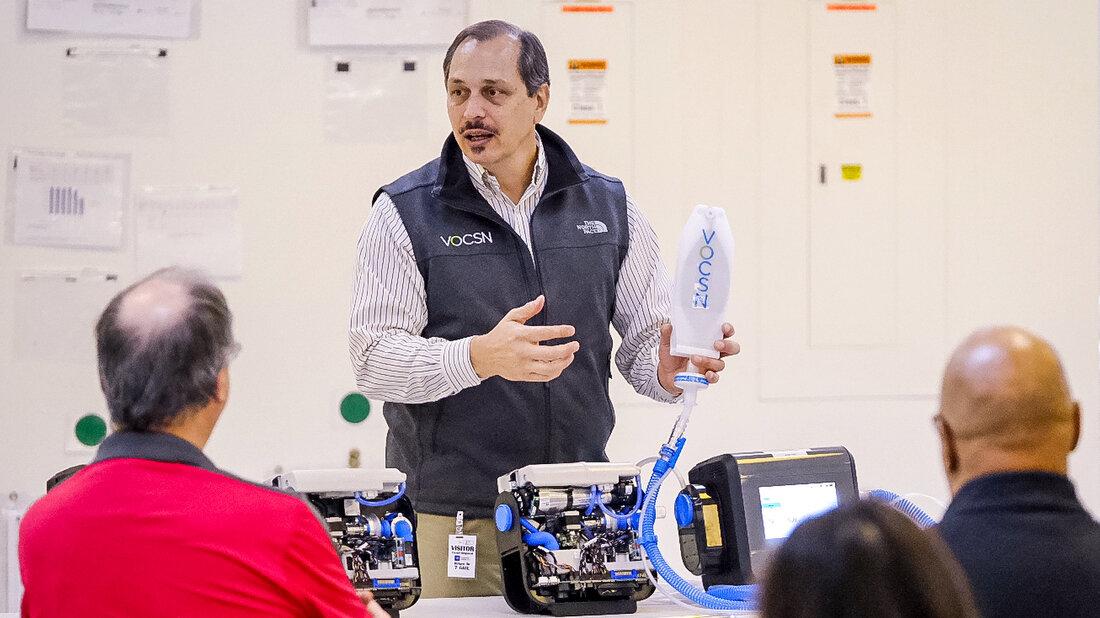America will not have a ventilator crisis. Ventilators might need to be relocated to outbreak hotspots, but between existing supply, and ventilator manufacturers rising to the occasion during this unprecedented, COVID-19 crisis, there will be enough ventilator supply to meet any Coronavirus 2019 demand.
How many ventilators the United States will need to meet the demands brought on by the novel coronavirus (COVID-19) remains unknown at this time. There are approximately 160,000 ventilators in hospitals across the United States. Many medical professionals fear that more ventilators may be required. The greatest fear is having a patient in need of a ventilator because the coronavirus has attacked his or her lungs, making it very difficult to breathe, and this life-saving piece of equipment not be available where the patient is located. This is a worst-case scenario.
Simply put, ventilators deliver air to the lungs. They are machines that help people breathe when they cannot breathe on their own. It has been reported that the United States has an additional 12,700 ventilators in the National Strategic Stockpile, a federal government inventory held for declared national emergencies. Even with these 12,700 ventilators added to the 160,000 in medical facilities across the nation, there remains a concern that there could be a shortage. It all depends on whether enough Americans heed the warnings from state and federal government officials, and take the necessary steps to avoid spreading COVID-19.
Preliminary data from this past week shows that there has been a significant shift in behaviors. Adults are taking action to protect themselves from getting the virus or spreading it. Unfortunately, younger adults and teenagers have focused on reports that suggest they will most likely not get extremely sick from the virus. This is true. But what this younger generation is ignoring is the likelihood that they will become the largest segment of the population most likely to spread the virus to people the virus might kill. Images of college age adults partying on beaches in Florida and California this past week illustrates the health concern.
Over the weekend, California Governor Gavin Newsom has this to say. “Those young people are still out there on the beaches thinking it’s time to party. It’s time to grow up, time to wake up. Time to recognize that it’s not just about the old folks, it’s about your impact on their lives. Don’t be selfish.” An argument can be made that if all Americans, including the 15-24 age group, stayed home except for necessary work, medical attention, and getting food / supplies, the concern about whether the United States has enough ventilators would be greatly reduced. It should be expected that in states with the largest amount of people tested positive for COVID-19, stricter emergency actions will be implemented to get the younger adults in compliance.
While it is best to be prepared for worst-case scenarios, prudence should pacify panic. The federal government is preparing to offer up over one trillion dollars of new debt in response to the COVID-19 pandemic. Some of that money will be used to purchase ventilators. Some states have been very vocal about the need for more ventilators, but none want to spend the money for them. They expect the federal government to pay for the ventilators. And when the federal government agrees to pay for panic purchasing, the price tag skyrockets!
One thing is certain. All manufacturers of ventilators agree that there are not enough ventilators. In a capitalist economy, it’s a great time to be in the medical supply business. There is nothing distasteful about profit while satisfying a supply and demand crisis. It is the potential profit that will ensure that the demand is fulfilled. However, overcharging the taxpayers to gain more than a healthy profit, especially when selling a life-saving piece of equipment, should not be accepted. Fortunately, there are enough American manufacturers of ventilators to shake out a fair, market value price through the bidding process.
The question remains though. How many ventilators does the United States need at this time? What percentage of people that have tested positive for COVID-19 in the United States required a ventilator to help them breathe? A team of data scientists at Penn Medicine / Predictive Healthcare have built a model to help hospitals predict how COVID-19 will impact their facility and ability to deliver care to every patient. The model is named CHIME (COVID-19 Hospital Impact Model for Epidemics). How each hospital benefits from this model depends on the virus saturation in the surrounding community.
Since the first case of COVID-19 was detected in the United States on January 21, 2020, there are now over 35,000 people infected in the United States. 358 people have died from the virus. This rapid compounding of the virus demonstrates how quickly it will spread if Americans do not isolate. It must be remembered that some people with the virus experience little or no sickness. When these people interact in close proximity with other people, they are spreading the virus. The current reproduction number is 2.5, meaning an infected person is spreading the virus to 2.5 other people. If Americans do not greatly reduce the 2.5 reproduction number, many people will die.
If there is good news, it’s the fact that only 5% of people that have COVID-19 require hospitalization. This means that 95% of people that become infected with COVID-19 experience mild to moderate flu symptoms only. The bad news is these people are the primary virus spreaders. Some are super-spreaders.
Of the 5% of hospitalized patients, it is estimated that 2% are in Intensive Care Units (ICU). 1% of the patients require a ventilator. If the percentage of COVID-19 patients that require a ventilator stays at or near 1%, and the United States reduces the 2.5 reproduction number down to 1 or less, there are enough ventilators. If over half of California gets the virus as Governor Newsom predicts will happen if Californians fail to comply with mitigation efforts, and the rest of the country follows suit, then it is possible that there could be a shortage of ventilators, at certain hospitals, if no new ventilators became available.
This should be of little concern because new ventilators are indeed being manufactured at an increased pace. At this moment – there is a real sense of urgency at every ventilator manufacturing and distribution facility in the United States. Rest assured; American manufacturers and suppliers will rise to meet the nation’s demand. It might be a race against time, but it is a race that will be won because Americans still rise up together against a foreign adversary – whether a terrorist or a virus.





Comments are closed.